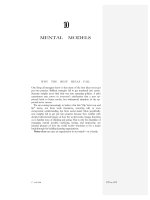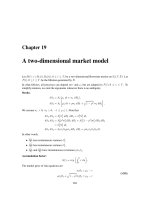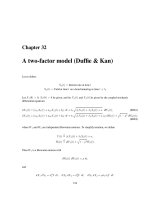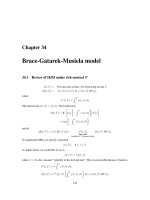Cox-Ingersoll-Ross model
Bạn đang xem bản rút gọn của tài liệu. Xem và tải ngay bản đầy đủ của tài liệu tại đây (197.29 KB, 16 trang )
Chapter 31
Cox-Ingersoll-Ross model
In the Hull& Whitemodel,
rt
is a Gaussianprocess. Since, for each
t
,
rt
is normallydistributed,
there is a positiveprobabilitythat
rt 0
. The Cox-Ingersoll-Rossmodel is the simplest one which
avoids negative interest rates.
We begin with a
d
-dimensional Brownian motion
W
1
;W
2
;::: ;W
d
.Let
0
and
0
be
constants. For
j =1;::: ;d
,let
X
j
0 2 IR
be given so that
X
2
1
0 + X
2
2
0 + :::+ X
2
d
0 0;
and let
X
j
be the solution to the stochastic differential equation
dX
j
t=,
1
2
X
j
t dt +
1
2
dW
j
t:
X
j
is called the Orstein-Uhlenbeck process. It always has a drift toward the origin. The solution to
this stochastic differential equation is
X
j
t=e
,
1
2
t
X
j
0 +
1
2
Z
t
0
e
1
2
u
dW
j
u
:
This solution is a Gaussian process with mean function
m
j
t=e
,
1
2
t
X
j
0
and covariance function
s; t=
1
4
2
e
,
1
2
s+t
Z
s^t
0
e
u
du:
Define
rt
4
= X
2
1
t+X
2
2
t+:::+ X
2
d
t:
If
d =1
,wehave
rt= X
2
1
t
and for each
t
,
IP frt 0g =1
, but (see Fig. 31.1)
IP
There are infinitely many values of
t0
for which
rt= 0
=1
303
304
t
r(t) = X (t)
x
x
1
2
( X (t), X (t) )
1
1
2
2
Figure 31.1:
rt
can be zero.
If
d 2
, (see Fig. 31.1)
IP f
There is at least one value of
t0
for which
rt= 0g =0:
Let
f x
1
;x
2
;::: ;x
d
=x
2
1
+x
2
2
+:::+ x
2
d
.Then
f
x
i
=2x
i
; f
x
i
x
j
=
2
if
i = j;
0
if
i 6= j:
Itˆo’s formula implies
drt=
d
X
i=1
f
x
i
dX
i
+
1
2
d
X
i=1
f
x
i
x
i
dX
i
dX
i
=
d
X
i=1
2X
i
,
1
2
X
i
dt +
1
2
dW
i
t
+
d
X
i=1
1
4
2
dW
i
dW
i
= ,rt dt +
d
X
i=1
X
i
dW
i
+
d
2
4
dt
=
d
2
4
, rt
!
dt +
q
rt
d
X
i=1
X
i
t
p
rt
dW
i
t:
Define
W t=
d
X
i=1
Z
t
0
X
i
u
p
ru
dW
i
u:
CHAPTER 31. Cox-Ingersoll-Ross model
305
Then
W
is a martingale,
dW =
d
X
i=1
X
i
p
r
dW
i
;
dW dW =
d
X
i=1
X
2
i
r
dt = dt;
so
W
is a Brownian motion. We have
drt=
d
2
4
, rt
!
dt +
q
rt dW t:
The Cox-Ingersoll-Ross (CIR) process is given by
drt= ,rt dt +
q
rt dW t;
We define
d =
4
2
0:
If
d
happens to be an integer, then we have the representation
rt=
d
X
i=1
X
2
i
t;
but we do not require
d
to be an integer. If
d2
(i.e.,
1
2
2
), then
IP f
There are infinitely many values of
t0
for which
rt=0g =1:
This is not a good parameter choice.
If
d 2
(i.e.,
1
2
2
), then
IP f
There is at least one value of
t0
for which
rt= 0g =0:
With the CIR process, one can derive formulas under the assumption that
d =
4
2
is a positive
integer, and they are still correct even when
d
is not an integer.
For example, here is the distribution of
rt
for fixed
t0
.Let
r0 0
be given. Take
X
1
0 = 0;X
2
0 = 0; ::: ; X
d,1
0 = 0;X
d
0 =
q
r0:
For
i =1;2;::: ;d, 1
,
X
i
t
is normal with mean zero and variance
t; t=
2
4
1 , e
,t
:
306
X
d
t
is normal with mean
m
d
t=e
,
1
2
t
q
r0
and variance
t; t
.Then
rt= t; t
d,1
X
i=1
X
i
t
p
t; t
!
2
| z
Chi-square with
d , 1=
4,
2
2
degrees of
freedom
+ X
2
d
t
| z
Normal squaredand independent of the other
term
(0.1)
Thus
rt
has a non-central chi-square distribution.
31.1 Equilibrium distribution of
r t
As
t!1
,
m
d
t!0
.Wehave
rt= t; t
d
X
i=1
X
i
t
p
t; t
!
2
:
As
t!1
,wehave
t; t=
2
4
, and so the limiting distribution of
rt
is
2
4
times a chi-square
with
d =
4
2
degrees of freedom. The chi-square density with
4
2
degrees of freedom is
f y =
1
2
2=
2
,
2
2
y
2,
2
2
e
,y=2
:
We make the change of variable
r =
2
4
y
. The limiting density for
rt
is
pr=
4
2
:
1
2
2=
2
,
2
2
4
2
r
2,
2
2
e
,
2
2
r
=
2
2
2
2
1
,
2
2
r
2,
2
2
e
,
2
2
r
:
We computed the mean and variance of
rt
in Section 15.7.
31.2 Kolmogorov forward equation
Consider a Markov process governed by the stochastic differential equation
dX t=bXt dt + X t dW t:
CHAPTER 31. Cox-Ingersoll-Ross model
307
-
h
0
y
Figure 31.2: The function
hy
Because we are going to apply the following analysis to the case
X t= rt
, we assume that
X t 0
for all
t
.
We start at
X 0 = x 0
at time 0. Then
X t
is random with density
p0;t;x;y
(in the
y
variable). Since 0 and
x
will not change during the following, we omit them and write
pt; y
rather
than
p0;t;x;y
.Wehave
IEhXt =
Z
1
0
hy pt; y dy
for any function
h
.
The Kolmogorov forward equation(KFE) is a partial differentialequationin the “forward” variables
t
and
y
. We derive it below.
Let
hy
be a smooth function of
y 0
which vanishes near
y =0
and for all large values of
y
(see
Fig. 31.2). Itˆo’s formula implies
dhX t =
h
h
0
X tbX t +
1
2
h
00
X t
2
X t
i
dt + h
0
X tX t dW t;
so
hX t = hX 0 +
Z
t
0
h
h
0
X sbX s +
1
2
h
00
X s
2
X s
i
ds +
Z
t
0
h
0
X sX s dW s;
IEhXt = hX 0 + IE
Z
t
0
h
h
0
X sbX s dt +
1
2
h
00
X s
2
X s
i
ds;
308
or equivalently,
Z
1
0
hy pt; y dy = hX 0 +
Z
t
0
Z
1
0
h
0
y by ps; y dy ds +
1
2
Z
t
0
Z
1
0
h
00
y
2
y ps; y dy ds:
Differentiate with respect to
t
to get
Z
1
0
hy p
t
t; y dy =
Z
1
0
h
0
y by pt; y dy +
1
2
Z
1
0
h
00
y
2
y pt; y dy :
Integration by parts yields
Z
1
0
h
0
y by pt; y dy = hy by pt; y
y=1
y=0
| z
=0
,
Z
1
0
hy
@
@y
bypt; y dy ;
Z
1
0
h
00
y
2
y pt; y dy = h
0
y
2
y pt; y
y=1
y=0
| z
=0
,
Z
1
0
h
0
y
@
@y
2
ypt; y
dy
= ,hy
@
@y
2
ypt; y
y=1
y=0
| z
=0
+
Z
1
0
hy
@
2
@y
2
2
ypt; y
dy :
Therefore,
Z
1
0
hy p
t
t; y dy = ,
Z
1
0
hy
@
@y
bypt; y dy +
1
2
Z
1
0
hy
@
2
@y
2
2
ypt; y
dy ;
or equivalently,
Z
1
0
hy
"
p
t
t; y +
@
@y
bypt; y ,
1
2
@
2
@y
2
2
ypt; y
dy =0:
This last equation holds for every function
h
of the form in Figure 31.2. It implies that
p
t
t; y +
@
@y
by pt; y ,
1
2
@
2
@y
2
2
ypt; y
=0:
(KFE)
If there were a place where (KFE) did not hold, then we could take
hy 0
at that and nearby
points, but take
h
to be zero elsewhere, and we would obtain
Z
1
0
h
"
p
t
+
@
@y
bp ,
1
2
@
2
@y
2
2
p
dy 6=0:









